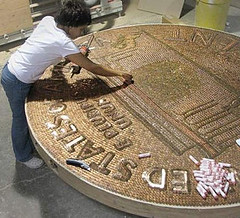
About UsThe Numismatic Bibliomania Society is a non-profit organization promoting numismatic literature. For more information please see our web site at coinbooks.org SubscriptionsThose wishing to become new E-Sylum subscribers (or wishing to Unsubscribe) can go to the following web page link MembershipThere is a membership application available on the web site Membership Application To join, print the application and return it with your check to the address printed on the application. Membership is only $15 to addresses in the U.S., $20 for First Class mail, and $25 elsewhere. For those without web access, write to: David M. Sundman, Secretary/TreasurerNumismatic Bibliomania
Society AsylumFor Asylum mailing address changes and other membership questions, contact David at this email address: dsundman@LittletonCoin.com SubmissionsTo submit items for publication in The E-Sylum, just Reply to this message, or write to the Editor at this address: whomren@coinlibrary.com
BUY THE BOOK BEFORE THE COINYou won't regret it! |
- WAYNE'S WORDS: THE E-SYLUM FEBRUARY 13, 2011
- DEALER STEVE TANENBAUM FELLED BY KILLER IN NEW YORK RAMPAGE
- DOUBLE ISSUE ASYLUM IS ON ITS WAY: JULY-DECEMBER 2010
- AOL SUBSCRIBERS BACK ON TRACK
- LAKE BOOK SALE #106 PRICES REALIZED AVAILABLE
- NEW BOOK: COLLECTING WORLD COINS: CIRCULATING ISSUES, 1901-PRESENT
- AN INTERVIEW WITH ERIC II AUTHOR RAS SUAREZ
- TIM SHUCK ON THE CCAC BLUEPRINT FOR U.S. COIN EXCELLENCE
- TWO ALASKAN MEDALS IN CERAMIC OR PORCELAIN
- QUERY: WHO SAID STEPHEN NAGY WAS JOHN HASELTINE'S SON-IN-LAW?
- QUERY: 1945 NICKEL WITHOUT MINTMARK INFO SOUGHT
- THE WASHINGTON ROMAN HEAD CENT
- ONLINE EXHIBIT: COINS & CURRENCY IN COLONIAL AMERICA
- WHERE TO GET THE CHAIR
- NOTES FROM E-SYLUM READERS: FEBRUARY 13, 2011
- WAYNE'S NUMISMATIC DIARY: FEBRUARY 13, 2011
- MEDAL OF HONOR COMMEMORATIVE COIN IMAGES RELEASED
- A LECTURE ON THE COINS OF 3RD CENTURY IRAN
- BERNHARD BEHEIM THE ELDER: THE MAN WHO INVENTED THE TALER
- SRI LANKA ISSUES NEW BANKNOTES
- MICHIGAN MOM'S GIANT PENNY: IS IT ART?
- MUBARAK'S DOWNFALL COULD THREATEN ROYAL MINT'S COINAGE CONTRACT
- FEATURED WEB PAGE: HISTORIA NUMORUM EGYPT
WAYNE'S WORDS: THE E-SYLUM FEBRUARY 13, 2011

Among our new subscribers this week are Dick Wells and Phillip Gotner, courtesy of John and Nancy Wilson, Arianna D'Ottone, and Evgeny Zakharov. Welcome aboard! We now have 1,403 email subscribers, plus 118 followers on Facebook, including Bob Johnson and Abhay Bhalerao.
This week we open with tragic news of the untimely death of another titan in the world of U.S. numismatics. Next, we have word about the latest issue of The Asylum, our AOL problems, and Fred Lake's recent sale.
Other topics include the Citizens Coinage Advisory Committee, the Washington Roman Head cent, the Medal of Honor commemoratives, and an interview wit ERIC II author Ras Suarez. To learn more about Stephen K. Nagy, Henning's counterfeit nickels, and numismatics of the Grateful Dead, read on. Have a great week, everyone!
Wayne Homren
Numismatic Bibliomania Society
DEALER STEVE TANENBAUM FELLED BY KILLER IN NEW YORK RAMPAGE
Joe Levine spread the word on Saturday, forwarding a copy of a newspaper article on the killer's rampage which spanned nearly 28 hours and two boroughs. After stabbing people in a crowded subway, he then drove to the home of his former girlfriend, killing her and stabbing her mother.
He then jumped into his car, smashing into another vehicle. He stabbed that driver in the chest, leaving him in stable condition. He then sped off, hitting and killing pedestrian Stephen Tanenbaum.
At that point I'd only seen the story but had not heard confirmation that the pedestrian was the Stephen Tanenbaum known in the numismatic community. David Gladfelter wrote:
It is probably our Steve because he lived in Brooklyn. I don't know much about Steve's family but know that he had a brother. If anyone can reach Rich Rossa, his former business partner, we might get more information.
On Sunday I heard from John Kraljevich, who writes:
I spoke to Rich Rossa, Steve's long time partner and friend. He's in touch with Steve's family. One of Steve's brothers is already in New York City making arrangements, another is on the way. Steve was apparently walking to the bank late yesterday afternoon when this unspeakable tragedy happened. Rich is handling it pretty well. As he told me, simply, "Steve's time was just up."
When I was about 11, toting my mom around to coin shows, there was a select group of dealers who were happy to just sit, talk, and teach. Steve was one of them. We've been friends ever since and I'll miss him.
December took Cameron Kiefer, January took Joe Lasser, now Steve in February. Enough already.
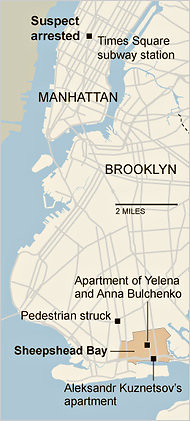 A fugitive with a knife, who the police said had left behind a calamity of murders and broken lives in Brooklyn, was captured by officers at Times Square on Saturday morning after stabbing another victim on a subway train, investigators said.
A fugitive with a knife, who the police said had left behind a calamity of murders and broken lives in Brooklyn, was captured by officers at Times Square on Saturday morning after stabbing another victim on a subway train, investigators said.
It was the culmination of a roller-coaster of violence that included three fatal stabbings; a hit-and-run homicide; four other stabbings; four auto thefts, including two carjackings; death threats against several others who got in the way; a dangerous manhunt by hundreds of police officers; and for millions of New Yorkers a round-the-clock ordeal of a killer on the loose in the city.
Mr. Kelly said he had never encountered a crime spree like Mr. Gelman's. "It's so horrendous and bizarre," he said at an afternoon news conference. "Obviously, if he wasn't apprehended this morning, he could have injured, killed, many more people."
The arrest was the climax of a 28-hour drama in which, the police said, Mr. Gelman killed his mother's companion as well as his former girlfriend and her mother in knife attacks at two apartments in Sheepshead Bay, Brooklyn, then seized a car, stabbed the driver, fatally struck a pedestrian and sped away.
To read the complete article, see: Suspect in Brooklyn Stabbing Spree Is Captured (www.nytimes.com/2011/02/13/nyregion/13stab.html)
The stabbing spree started just after 5 a.m. Friday, when police say Gelman fatally knifed his stepfather, Aleksandr Kuznetsov, at their apartment in Brooklyn's Sheepshead Bay neighborhood. Gelman had gotten into a fight with his mother after she refused to allow him to use her Lexus, and Kuznetsov intervened and was attacked, Kelly said.
Police found the 54-year-old man's body at his home in the predominantly Eastern European immigrant neighborhood. The Ukrainian-born Gelman and his mother became naturalized U.S. citizens in 2004 or 2005, Kelly said.
At about 10:30 a.m., several blocks away, Gelman entered the home of his ex-girlfriend and used a kitchen knife to fatally stab her mother, 56-year-old Anna Bulchenko, Kelly said. When 20-year-old Yelena Bulchenko arrived home at about 4 p.m., she found her mother dead in a pool of blood and called 911, police said.
Gelman apparently was still in the house, chasing Bulchenko as she fled outside and stabbing her 11 times as she died, Kelly said.
He then sped away in the Lexus to Brooklyn's Midwood neighborhood, rear-ending a Pontiac. The driver confronted Gelman and was stabbed three times in the chest but survived and was in stable condition, Kelly said.
Gelman drove off in the Pontiac, hitting 62-year-old pedestrian Stephen Tanenbaum, who died of his injuries, police said. He later abandoned the car, engine running, in the driveway of a private house in Midwood, not far from a freight railroad line "Gelman frequented as a graffiti artist," Kelly said.
To read the complete article, see: Police: Man kills 4 in stabbing rampage in NYC (www.usatoday.com/news/nation/2011-02-12-new-york-stabbings_N.htm)
Donald Erlenkotter, Editor and Past President of the Civil War Token Society forwarded this from the CWTS Hall of Fame section on the Society's Web site:
Stephen L. Tanenbaum
Steve Tanenbaum is considered by many to be the most knowledgeable active person in the field of Civil War tokens. He has been relied upon for many decades as a consultant, editor, and contributor to numerous CWT works. After beginning his CWT collecting journey in 1972, he became a full-time dealer for tokens in 1981. Steve has handled, purchased, and built some of the greatest modern-day collections, although he always considers himself a collector first. He has discovered hundreds of new varieties, previously unknown die states, and odd mint errors. Steve has been elected to eight terms on the Board of Governors, and also filled two partial terms by appointment. He has served as Vice President of the Society since 2004.
David Gladfelter writes:
Steve was vice president of the Civil War Token Society and participated actively in many of its projects, primarily, the upcoming third edition of the store card catalog originally written by George and Melvin Fuld. He was a major contributor to Russell Rulau's catalog of American tokens, published by Krause Publications.
He was in charge of the CWTS Hall of Fame medal program which has honored such persons as George and Melvin Fuld, Julius Guttag, George Hetrich, Jack Detwiler and Joseph N. T. Levick. He knew John J. Ford. Jr. very well and was as close to being Ford's confidant as just about anybody. He had several exhibits at the American Numismatic Society over the years. He was a walking encyclopedia of token and medal information.
He was well known, well liked and well respected throughout the numismatic community. A huge loss to all.
Another time I appraised a collection of coins in the Pittsburgh area and found a neat colonial coin with a New York merchant counterstamp. Steve had a huge personal collection of New York tokens and he bought the piece for top dollar.
Many a time I decided not to buy certain tokens from Steve because his selling prices seemed top dollar as well. But that's the natural position for someone who makes the market in a particular collectible. Of course, the market has advanced many times since then and naturally I wish I'd bought far more from Steve.
One of the last times I spoke to Steve was in 2006. I got a phone call from him from out of the blue after the American Numismatic Rarities catalog of my civil war collection came out. He had apparently spent twenty years looking for the New York cardboard scrip tokens in my collection, and had despaired of ever finding them on the market again. He bought most of them in the sale, again for his personal collection. It will be interesting to see his that collection come up for sale someday - I'm sure it contains some blockbuster token rarities.
What a sad end for one of the nicest and most knowledgeable numismatists in the country. Our thoughts are with his family in this time of shock and sorrow. -Editor
DOUBLE ISSUE ASYLUM IS ON ITS WAY: JULY-DECEMBER 2010
David Yoon, editor of our print publication The Asylum writes:
I've sent another issue of The Asylum to the printers. It's a double issue, vol. 28 no. 3-4. Here are the contents.
- Alan Luedeking - A Tribute to Humberto Burzio
- Jeffrey LaPlante - Where Are They Now? Regarding Ron Fern...
- Dave Hirt - Additional Catalogues from the Wylie Hoard?
- Joel J. Orosz - A Little Dry Reading for the Antiquaries (Part Three)
- Myron Xenos - "You Don't Say": Numismatic Quarterly Quiz
- Francis D. Campbell - Fifty Years in a Numismatic Library: Address to the NBS Annual Meeting, 2010
- Pete Smith - Comment: The Mint Courtyard
- The NBS Symposium, 2010
- The NBS Annual Meeting, Boston, August 2010
There is a membership application available on the NBS web site at
www.coinbooks.org/club_nbs_member_app.html .
To join, print the application and return it with your check to the address printed on the application. Membership is only $15 to addresses in the U.S., $20 for First Class mail, and $25 elsewhere. For those without web access, write to:
David M. Sundman,
Secretary/Treasurer
Numismatic Bibliomania Society
P. O. Box 82 Littleton, NH 03561
-Editor
AOL SUBSCRIBERS BACK ON TRACK
AOL subscribers including Len Harsel, Ron Ward, Donn Pearlman, Alan Weinberg, and Dave Baldwin are reporting our recent adjustment seems to have helped get past the problem that had been keeping many of them from reading the emailed version of The E-Sylum.
As a bonus, the changes have helped the situation at at least one other provider. David Gracey writes:
Past editions of The E-Sylum came through but somewhat garbled and with no photos. I assumed it was my email provider and decided to just live with it. I just finished the latest E-Sylum which came through intact, pictures included. What a difference! Congratulations.
To read the earlier E-Sylum article, see: BREAKTHROUGH FOR AOL E-SYLUM READERS? (www.coinbooks.org/esylum_v14n06a02.html)
LAKE BOOK SALE #106 PRICES REALIZED AVAILABLE
The prices realized list for our sale #106 which closed at 5:00 PM (EST) on February 8. 2011 is now posted on our web site at http://www.lakebooks.com/current.html . You can also find the PRL on our "Past Sales" page.
The sale was very busy with 490 of the 507 lots being sold. Lots containing original editions of the Colonial News Letter were in great demand and brought very high prices. Reference material on paper money was also on the "buy" list of many bidders. A complete run of the John J. Ford, Jr. catalogs was auctioned by individual sales at substantial figures.
Our next sale will be held in early April. Remember to bid early as tie bids are won by the earliest bid received.
Lake Books
6822 22nd Ave. N.
St. Petersburg, FL 33710
727-343-8055 Fax 727-345-3750
http://www.lakebooks.com
NEW BOOK: COLLECTING WORLD COINS: CIRCULATING ISSUES, 1901-PRESENT
 The most comprehensive catalog of 20th and 21st century circulating world coins is back from Krause Publications.
The most comprehensive catalog of 20th and 21st century circulating world coins is back from Krause Publications.
Collecting World Coins: Circulating Issues, 1901-Present is now available. The 13th edition of this catalog contains listings and more than 18,500 detailed coin illustrations of circulating issues worldwide. Non-circulating legal tender issues are not included.
The country-by-country organization of this book makes it easy to find the countries and coins collectors are interested in, and illustrations aid in identifying subtle differences between similar issues.
Edited by world coin experts George Cuhaj and Tom Michael, the book's listings include dates and mintages, metal composition, weight and current market value.
For more information visit www.shopnumismaster.com/product/collecting-world-coins-13th-ed/new .
Editor George S. Cuhaj is a 17-year veteran of Krause Publications' Numismatic Catalog Division, where he is also the editor of the Standard Catalog of World Coins series. Cuhaj hails from New York City, where he was previously on staff with the American Numismatic Society, Stack's Rare Coins and R.M. Smythe & Co. He is a frequent instructor at the American Numismatic Association's Summer Seminars.
Market Analyst Tom Michael serves as market analyst for Krause Publications coin catalogs, and has done so for more than 90 world and U.S. coin catalogs. He has more than 20 years of experience researching and reporting on world coin prices and market trends.
THE BOOK BAZARRE
AN INTERVIEW WITH ERIC II AUTHOR RAS SUAREZ
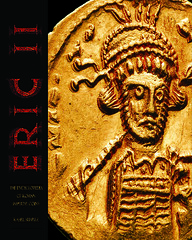 Today, Tyler R. Tichelaar of Reader Views is excited to interview Rasiel Suarez, who is here to discuss his new book "ERIC II: The Encyclopedia of Roman Imperial Coins."
Today, Tyler R. Tichelaar of Reader Views is excited to interview Rasiel Suarez, who is here to discuss his new book "ERIC II: The Encyclopedia of Roman Imperial Coins."
Rasiel Suarez is a specialist in ancient Roman coins. As a child he collected stamps and coins, like many other kids his age, but eventually left these collections dormant despite retaining an avid interest in history and geography. This interest eventually led to a Bachelor's in Political Science from the University of Rhode Island. During the 90's, trips to Europe, and later the advent of eBay, rekindled his interest in coins. In 2002, he and his wife founded Dirty Old Coins, a company that brought the hobby to thousands of mainstream families throughout the world. In 2005 the release of "The Encyclopedia of Roman Imperial Coins" (ERIC for short) was well received by fans of the series and the initial run sold out soon after. November of 2010 saw the publishing of "ERIC II," the fully revised and long awaited sequel, which promises to be a landmark achievement in Roman numismatics. The author lives with his family in Olympia, Washington.
Tyler: Welcome, Rasiel. As a coin collector myself, I'm excited to interview an author who knows a lot about coin collecting. To get started, will you tell us a little bit about how you got started with coin collecting?
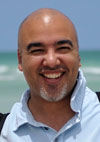 Rasiel: Thank you, Tyler. Well, like many other kids back in the days before the Internet and video games I collected stamps and coins but the interest died down during my teens. Shortly after 9/11, I found myself out of work and it was then that I stumbled on these Roman coins being sold on eBay. I was skeptical at first but took the chance to see if they were real or whether I was a sucker. They were being sold as lumps of hardened dirt which you were supposed to carefully clean in order to restore the coin to its original condition—much like you imagine an archeologist brushing an artifact. That they were being sold for only a dollar or two each with the promise that restoration could yield a treasure was enough to get me hooked into coins again.
Rasiel: Thank you, Tyler. Well, like many other kids back in the days before the Internet and video games I collected stamps and coins but the interest died down during my teens. Shortly after 9/11, I found myself out of work and it was then that I stumbled on these Roman coins being sold on eBay. I was skeptical at first but took the chance to see if they were real or whether I was a sucker. They were being sold as lumps of hardened dirt which you were supposed to carefully clean in order to restore the coin to its original condition—much like you imagine an archeologist brushing an artifact. That they were being sold for only a dollar or two each with the promise that restoration could yield a treasure was enough to get me hooked into coins again.
Tyler: What made you decide to write a book about Roman Imperial Coins?
Rasiel: Back then there was relatively little up-to-date information about the coins and efforts to bring what there was into the digital age had just begun. I had gotten a number of books and visited some of these earlier websites but had that inner conviction that I could do better myself. I didn't know I was going to write a book yet, but I had begun the initial phase of research by putting together a huge database of coins from past sales and then published this initial effort online. It proved to be a good starting point from which to take the project offline in the form of a book which could be used by anyone with a passing interest in Roman coins, as opposed to a scholar or an advanced collector. The first edition took two years to complete as I found time in between work and family. The second edition, however, consumed just about every waking hour of my life for the next five years!
Tyler: I admit I was a bit confused by the title ERIC II at first, but then realized it's an acronym for "Encyclopedia of Roman Imperial Coins" which is the subtitle. And the II is because it's the second edition. What additions or changes have been made from the first edition?
Rasiel: Initially, I did have in mind more modest goals for a second edition. There were many editing errors and the catalog was very basic. I had in mind to correct the errors and bring it a degree closer along the road of being fully comprehensive. However, I became disillusioned with this plan since deep down what I really wanted was to author a definitive reference, one I would use instead of any other. Except for sections of the introduction and the general format, this second edition is essentially remade from the ground up and includes new features which were asked for by the collecting community whom I constantly engaged. It is also the first time a Roman coin book includes a full survey of the coinage of the Byzantine Empire.
Tyler: Why did you decide to create an "encyclopedia" of Roman Imperial Coins? I assume that "encyclopedia" means it covers far more than just a Roman coin collecting book would cover?
Rasiel: Well, honestly, it was just a handy acronym in honor of my first son Eric. But, with the goal of trying to include everything relevant about the emperors and their coins, not many other suitable titles came to mind. The Roman Coin Bible? Roman Coins for Dummies? Too hackneyed.
Tyler: Has Roman coin collecting been popular for a long time, or has it only been in recent years that more people have grown interested in Roman coins?
Rasiel: A Roman historian noted that Augustus himself had taken an interest in coins as keepsakes and would hand them out to friends and dignitaries. The evidence on the coins themselves suggest that while the majority were intended as nothing but cash, a few were issued in such limited quantities and with such care of manufacture that they were every bit the equivalent of modern presentation pieces meant to be kept rather than spent.
Tyler: I can only imagine how much work went into this book, not just in research, but layout, photographs, printing. What was the most challenging part of writing and producing "Eric II"?
Rasiel: Those long lists of coins that often stretch across a dozen pages or more were, I'm not going to lie, pure hell. Imagine writing something like a phone book from scratch except that for each new number you put down, you have to verify the information and do a number of cross-references to other numbers. And if you add an out-of-sequence number or find an error, all the rest of the numbers have to be updated. That's a fairly close analogy. Since my second son is autistic, perhaps his mother's dry observation that I am as well has some weight. How else to explain my ability to compile these lists day after day after year? The bios and the pics were a piece of cake, the reward for completing the list on each section!
Tyler: Do you foresee "ERIC II" becoming an ebook in the future, which would allow for the color to be retained while reducing the printing costs?
Rasiel: It's one of my most asked questions and I want to say yes. Even though the data files are nearly a gigabyte, making for one mammoth ebook, there are no major technical challenges to overcome. As a proof of concept, the pdf's are currently being reviewed on an iPhone, and I expect that further development can enhance the experience. As a business venture it remains to be seen whether, when, and how this should be done.
To read the complete article, see: Interview with Rasiel Suarez (readerviews.com/InterviewSuarez.html)
TIM SHUCK ON THE CCAC BLUEPRINT FOR U.S. COIN EXCELLENCE
Tim L. Shuck of Ames, IA writes:
I decided to stick my head in the lion's mouth (again) and critique the Citizens Coinage Advisory Committee's recent "A Blueprint for Advancing Artistic Creativity and Excellence in United States Coins and Medals".
To much fanfare and a touch of hype, the CCAC recently released "A Blueprint for Advancing Artistic Creativity and Excellence in United States Coins and Medals", a 62-page (including appendices) document with a cover appropriately designed with blue highlights.
Having read through the Blueprint a couple of times I'm not convinced this latest effort does indeed represent my interests as either a citizen or a collector. Why? Because the Blueprint is focused, still, on process and organization, and reads much like an internal management document. The CCAC apparently remains convinced that if process is improved, excellent coin design will automatically follow.

For example, the CCAC presents helpful charts (with detailed descriptions) and a flurry of acronyms as examples of things that presumably will improve the designs of United States coins and medals.
The proposed processes may indeed be better than what is currently in place. But are processes really how great design in any endeavor is produced, or more to the point, found? By following a chart?
There are many points outlined in the document that could be items for discussion, but I want to instead turn the point of this post elsewhere, to recent coin designs of other countries. There is another way to achieve excellent coin design - select rather than push.
Note that teams, juries, or committees are part of this effort for the purpose of selecting a design, not for managing the process of design. There is a big difference.
There is little discussion in the Blueprint about whether there might be too many U.S. coins and medals produced each year, potentially too many committees and/or meetings, an analysis of the possibility that maybe circulating coinage is today primarily just a means of commerce, or that additional staff and staff time commitments might actually make the perceived problems worse rather than better.
I don't think this is how great design happens. Wouldn't it be better to select the great designs from an array of good designs rather than trying to tweak a process so that it will somehow, some way result in good designs? Isn't the former how most of the 'classic' designs of the early 20th century, so highly appreciated today, came about?
Design evaluation is and always has been subjective, something I believe even CCAC members know. So why not opt for a simpler path, rather than a complicated path burdened by bureaucracy?


To read the complete article, see:
Adopt the CCAC Blueprint for U.S. Coin Excellence? Not so Fast.
(www.metacoin.com/main/2011/2/8/adopt-the-ccac
-blueprint-for-us-coin-excellence-not-so-fast.html)
TWO ALASKAN MEDALS IN CERAMIC OR PORCELAIN
The February 2011 issue of Alaskan Token Collector & Polar Numismatist pictured an interesting ceramic medal owner my E-Sylum contributor Phil Iverson. Editor Dick Hanscom kindly provided me with images of the piece and another medal mentioned in the article. Thanks! Also shown below is the text of the February 2011 item. -Editor

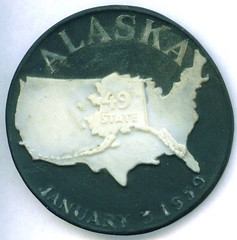
1959 Alaska Statehood medal
In the May 2008 issue Phil Iverson presented two ceramic or porcelain medals for our examination. One was the AYPE medal which was white on blue. The other was a 1959 Alaska Statehood medal. This one was grayish white on black.
Recently on eBay an example of the AYPE medal was offered for sale. As far as I could tell, it was identical to Phil's piece, including the MB on the reverse. It was called "Jasperware."
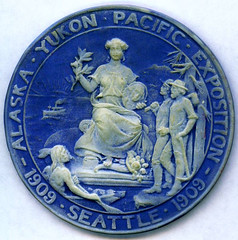
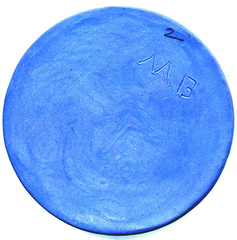
Alaska Yukon-Pacific Exposition Medal
Jasperware was developed by Josiah Wedgwood. In searching eBay for other examples, the white seems whiter and the boundaries between the two colors seem more distinct. The markings on the back do not indicate Wedgwood, so I doubt that this is Jasperware. It is, for lack of a better term, an interesting imitation. Price Realized - $152.50.
QUERY: WHO SAID STEPHEN NAGY WAS JOHN HASELTINE'S SON-IN-LAW?
Pete Smith writes:
In my book American Numismatic Biographies, I wrote that Stephen K. Nagy was the son-in-law of John Haseltine. I now believe this was an error.
John Haseltine married Rose A. Idler, the daughter of William Idler. They had one daughter, Marion, who married Thomas T. Richards.
Stephen K Nagy married Gertrude Devere, the daughter of Joseph and Minerva Devere. The photograph shows that Nagy has gone to his eternal rest between his wife and his mother-in-law. The cemetery is Egg Harbor City Cemetery in New Jersey.
My query: What was the original source for the statement that Nagy was son-in-law of Haseltine? Did this offer any specifics like the name of Haseltine's daughter and Nagy's wife?

THE 100 GREATEST U.S. MODERN COINS!
QUERY: 1945 NICKEL WITHOUT MINTMARK INFO SOUGHT
Web site visitor Craig Chambers writes:
"My uncle ran an ice cream franchise for many years from the 50's through the 80's and saved coins he thought might be valuable. I was going through some coins he left me after he died, and one of them is a 1945-P nickel. It has a large P on the back. But, there was another 1945 nickel that came with it and it has no mint mark at all. I Googled this and found your article:
"The E-Sylum: Volume 7, Number 13, March 28, 2004, Article 9, COUNTERFEITING CIRCULATING COINS." However, this deals with a 1944 counterfeit, not a 1945. Do you have any information on a mintmark-free 1945 nickel?"
Bob Leonard pointed out "Dwight H. Stuckey's booklet, The Counterfeit 1944 Jefferson Nickel (Published by the author, 1982)" The booklet notes that "Henning made the notorious 1944 no-mintmark nickel, plus five other obverses including 1939, 1946, 1947, and 1953 (the last date remains to be discovered)."
Craig has TWO of the mintmarkless nickels, a 1944 and a 1945. He provided the images below. What do people make of them? Could the 1945 be a previously unrecorded date of the Henning counterfeits? -Editor
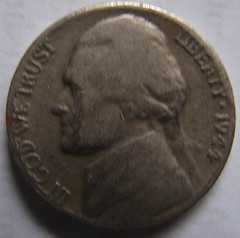
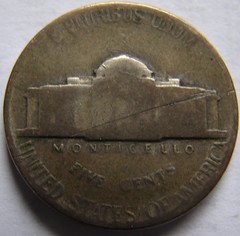
1944 No Mintmark Nickel
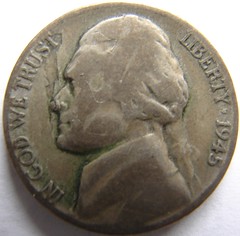

1945 No Mintmark Nickel
I posted the image of the 1945 reverse on our Facebook page for comment, asking "Who made this nickel? HINT: It wasn't the U.S. Mint."
Mathew Baca knew the answer. He writes:
Francis LeRoy Henning, aka "Henning's nickel"
Loren Gatch added:
He was in great need of a good five-cent cigar.
I asked Bob Leonard, who writes:
I looked at the images and the 1944 is a "genuine" Henning counterfeit (weak detail on Monticello, copper-nickel color), but the 1945 nickel is a normal Wartime silver nickel, as you can tell by the color. I believe that I can see traces of the mintmark over the dome, though it is quite weak. (Take another look).
Regarding Henning, though, according to an article in Coin World August 28, 1968, p. 33, Henning is known to have made dies with five different dates: 1939, 1944, 1946, 1947, and 1953. (He was afraid that tellers might become suspicious if all the deposits he brought in had the same date.) No 1945 is known.
Of these, the 1944 is the most obvious because it lacks the mintmark and is the wrong color. But the others can be recognized too; this article illustrates one of the 1939 counterfeits. All the Henning counterfeits can be positively identified though weak reverse detail, rough surface, and (in some cases) diebreaks.
 Thanks! I had never seen a War nickel so worn down that the mintmark was gone. I zoomed in on the photo, but I'm having trouble seeing remnants of a "P" mintmark. I'll ask Craig to take a closer look at the coin.
Thanks! I had never seen a War nickel so worn down that the mintmark was gone. I zoomed in on the photo, but I'm having trouble seeing remnants of a "P" mintmark. I'll ask Craig to take a closer look at the coin.
These counterfeits are interesting and certainly rarer than the genuine pieces. Other than Stuckey's booklet and the Coin World article, there's not much in the literature about these. Neat item, and a challenge to locate. Do any of our readers have examples of the Henning fakes? Anybody have a full set? -Editor
To read the earlier E-Sylum article, see: COUNTERFEITING CIRCULATING COINS (www.coinbooks.org/esylum_v07n13a09.html)
THE WASHINGTON ROMAN HEAD CENT
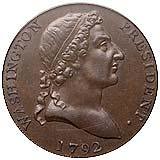
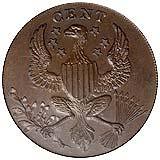
The exact number of surviving Washington Roman Head cents is unknown although the total is clearly small, given the number of pieces that appear in auctions. In our own sales since the beginning of our Permanent Auction Archives in 1993, just four auction appearances represent three different coins. The most recent was a PR61 Brown specimen that we sold in our 2011 FUN sale for $66,125. The same coin appeared in our May 2008 auction, where it realized $92,000. The piece we will be offering in our upcoming March Sacramento Signature ANA US Coin Auction, is far finer, grading Proof 64, and is pictured here.
Walter Breen told of the history of the Roman Head cent in his Complete Encyclopedia, attributing its origin to John Gregory Hancock, a young engraver at the Westwood Mint in Birmingham, England. Breen went so far as to say that the engraver was portraying Washington "as a degenerate, effeminate Roman emperor."
More recently, in the Whitman Encyclopedia of Colonial and Early American Coins, Dave Bowers suggests an entirely different concept, writing that "the Roman Head cent depicts Washington dressed in the style of a Roman official, a popular way of honoring him, at least in memory."
The Roman Head cents are part of the Conder token series and were made strictly for cabinet or collecting purposes, each showing a mirrored proof finish as seen on this example. Both sides have glossy brown surfaces with the fields and devices showing a mirrored finish. While small and scattered surface marks are visible, accumulating over more than two centuries of its existence, none stand out singularly.
To view the complete auction lot description, see: 1792 1C Washington Roman Head Cent (coins.ha.com/common/view_item.php?Sale_No=1153&LotIdNo=131001)
ONLINE EXHIBIT: COINS & CURRENCY IN COLONIAL AMERICA
Ray Williams writes:
I'm sure it was posted as a web site of the week before, but I feel it might be appropriate to post this again as a tribute to Joe Lasser and what he's done for our enjoyment of numismatics.

To visit the online exhibit, see: Coins & Currency in Colonial America (www.history.org/history/museums/coinExhibit/)
THE BOOK BAZARRE
WHERE TO GET THE CHAIR
Last week Stephen Pradier sent an image of an interesting Bibliophile's Chair. Mark Borckardt writes:
Where can I get one of those bibliophilic chairs? Please don't tease us without giving some guidance!

I asked Stephen where he found it. He writes:
It is made in Italy and appears to only be sold in Europe. Here are a couple of links:
www.nobodyandco.it/sito/inglese/the%20bibliochaise.html
3rings.designerpages.com/2010/01/25/bibliochaise-from
-nobodyco-no-bibliophile-can-resist/
To read the earlier E-Sylum article, see: NOTES FROM E-SYLUM READERS: FEBRUARY 6, 2011 (www.coinbooks.org/esylum_v14n06a16.html)
NOTES FROM E-SYLUM READERS: FEBRUARY 13, 2011
No sign of 1872 Coin Hoard
Dave Lange writes:
I looked through the Kleeberg book for a reference to the 1872 coin hoard mentioned in last week's issue but couldn't find it. His book is challenging to use, since the hoards are arranged by supposed date of deposit rather than by date of discovery. Searching it requires fairly specific knowledge of the coins involved or at least their dates.
To read the earlier E-Sylum article, see: QUERY: 1872 COIN HOARD FIND SOUGHT (www.coinbooks.org/esylum_v14n06a19.html)
Was That 1804 Dollar Silver?
Joe Boling writes:
What was the fake 1804 dollar made of? If silver, it's still a nice Salvation Army contribution.
To read the earlier E-Sylum article, see: FAKE 1804 DOLLAR DROPPED IN SALVATION ARMY KETTLE (www.coinbooks.org/esylum_v14n06a23.html)
A Grateful Dead Silver Round
 Phil Iversen published A Numismatic Tribute to Jerry Garcia and the Grateful Dead" in the January 2011 issue of The Numismatist. At my request he sent me an image of the 2000 commemorative one-ounce silver round pictured in the article. Thanks!
Phil Iversen published A Numismatic Tribute to Jerry Garcia and the Grateful Dead" in the January 2011 issue of The Numismatist. At my request he sent me an image of the 2000 commemorative one-ounce silver round pictured in the article. Thanks!
More Voices Against National Collector's Mint
The company, which sells its coins and collectibles out of Port Chester, N.Y., hasn't stopped trying to turn tragedy into cash. For the 10th anniversary of the Sept. 11, 2001, attacks, it has issued a commemorative coin bearing images of the World Trade Center and the U.S.S. New York, a ship built partly from ground zero steel.
It costs $29.95, a price that is hard to justify, no matter what claims the company makes about the source of the coin's silver coating. It is not real currency and has not been authorized or licensed by the United States government.
There is nothing wrong with companies selling memorabilia linked to moments of catastrophe or triumph, but both the law and basic decency should set some limits. These coins should come with big disclaimers: This product is 100 percent shame-free.
To read the complete article, see: .24 Karat Gall (www.nytimes.com/2011/02/10/opinion/10thu4.html)
To read the earlier E-Sylum article, see: LAWMAKERS ATTACK NATIONAL COLLECTOR'S MINT LATEST 9/11 "COINS" (www.coinbooks.org/esylum_v14n05a23.html)
Forged Signatures on Remaindered Obsolete Bank Notes
Ron Ward writes:
A large number of remainders of Broken Bank Notes are showing up on eBay. There is nothing wrong with this. However, buyers should be aware that some are priced at higher levels than are realized at some standard auctions. The disturbing point is that at times one of these remainder notes, in UNC condition, shows up on eBay with new signatures and a written number thus converting the remainder to an excellent condition circulated note, thus doubling or tripling its value. These notes have black signatures rather than the faded brownish signatures on the old notes, and the signatures often appear scribbled.
WAYNE'S NUMISMATIC DIARY: FEBRUARY 13, 2011
Since I wasn't there to report on Tuesday's festivities, Gene Brandenburg kindly forwarded the following note. Thanks! Sorry I missed the food at Tommy Thai! -Editor
Gene Brandenburg writes:
Tuesday was a success in spite of Dave Schenkman & I fumbling around Springfield trying to find the damn place (the "girl" in his GPS device heard expletives hurled at her never before uttered by mankind). We were late - the last to arrive - and were relegated to the "time out" end of the table.
The restaurant was plain & simple, and I was a bit leery when we were guided past restrooms into a back room that was rather spartan. But things got better from there. We started out with spring rolls & dumplings (fresh, well made - with unusually good dipping sauce) & things got better as the evening progressed. I even ordered carry-out to take home to my bride - we're not real strong on Asian food but this place was unusually good - above the fray. The place was clean and the service was warm & friendly, I'd put this place in the "keeper" category.
With the theme being portraits on coins, Dave brought a Leopold the Hogmouth Taler (he says it reminds him of Joe Levine). I brought a gothic crown of Victoria & an early 1 1/2 taler depicting Martin Luther (one year type from Eisleben, 1661). Also present was a large 19th century Washington medal with a Mount Vernon reverse. Members bring interesting stuff to every dinner, a real asset to these things. Someone (Levine, I believe) brought some new exonumia books - one had the worst photography I've seen recently in a numismatic reference book.
MEDAL OF HONOR COMMEMORATIVE COIN IMAGES RELEASED


Images of the upcoming Medal of Honor Commemorative Coins were recently posted on the US Mint's website. Until now, only the line-art images had been available.
The program was authorized by Congress to recognize and celebrate the establishment of the Medal of Honor, to honor its recipients, and to promote awareness of what the Medal represents and how ordinary Americans can challenge fate and change the course of history. The program includes a $5 gold coin with a maximum authorized mintage of 100,000, and a silver dollar with maximum mintage of 500,000.
The coins are scheduled to go on sale February 25, 2011.
-honor-commemorative-coin.html)
A LECTURE ON THE COINS OF 3RD CENTURY IRAN
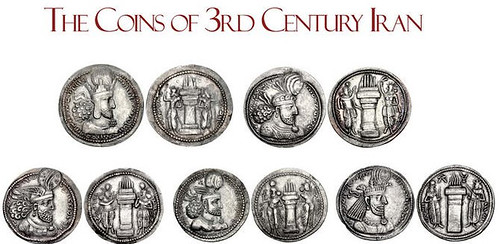
February 15, 2011
The Coins of 3rd Century Iran Numismatics and the Formation of Historical Criteria.
Dr. Rika Gyselen, Centre National de la Recherche Scientifique
3:30 p.m., Humanities Instructional Building, Room 135. Free
More: 949.824.1662.
For more information, see:
The Coins of 3rd Century Iran Numismatics and the Formation of Historical Criteria
(www.humanities.uci.edu/SOH/calendar/detail.php?recid=3155
&dept_code_val=all&file_name=events)
BERNHARD BEHEIM THE ELDER: THE MAN WHO INVENTED THE TALER
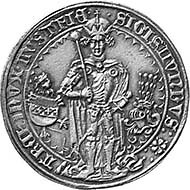
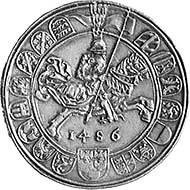
It was under Bernhard Beheim the Elder, whose tomb so many tourists of the city of Hall pass without taking further notice, that the first guldiner were minted, the big silver coins that were issued by Duke Sigismund Rich in Coin who had silver in abundance. These pieces with their weight being related to the gold gulden, whose silver equivalent they were designed to be, became the predecessor of the most common trade coin of early modern times, the taler.

His tomb shows Bernhard Beheim in the style of the Renaissance, in a sheer garment, his halfway rotten body eaten up by bugs, snakes, toads and snails. This pitiful representation was considered appropriate by early modern artists to visualize the horror of death and to state the human body gets into after death, in contrast to the undying soul. To the modern viewer that may seem odd since the sepulchral marker hardly betrays what important man it covers.
Bernhard Beheim the Elder was the person responsible for minting the gold coins of Sigismund Rich in Coin of Tyrol before he was appointed mint master in 1482 of the Hall Mint which had been established not long before, in 1477. Back then, he received an annual salary of 200 Mark and supervised roughly 20 employees. Bernhard Beheim seems to have been an innovative craftsman who, together with the executive senior civil servant of Sigismund, Anton vom Roß, was the leading figure in conducting the Tyrolean currency reform. After "inventing" the "pfundner", a coin worth 12 kreuzer, and the sechser, a coin of 6 kreuzer, a silver coin was designed worth 30 kreuzer or half a gold gulden and shortly afterwards the guldiner.
To read the complete article, see: What is left of the man who invented the taler (www.coinsweekly.com/en/page/5)
SRI LANKA ISSUES NEW BANKNOTES
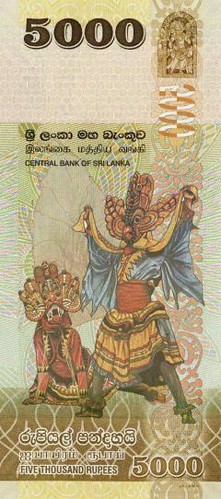 Sri Lanka after 20 years has issued a new series of currency notes on 2011 February 7th that I have posted at my website at
Sri Lanka after 20 years has issued a new series of currency notes on 2011 February 7th that I have posted at my website at
notes.lakdiva.org/2010/
My article on them appeared in the Sunday Times of Sri Lanka.
The Central Bank of Sri Lanka (CBSL) issued a new set of six currency notes into circulation on February 7 which will replace the current notes in circulation that were first issued in 1991. The new set includes a new Rs 5000 note. Images of the notes had been published in the local newspapers on January 28 and online on the CBSL website.
The notes have the date 2010-01-01 since the new notes were originally expected to be released at the CBSL 60th Anniversary celebrations in August 2010. The CBSL then announced that the notes would be released to the public at the Deyata Kirula exhibition which opened in Buttala on February 4. However lack of sufficient security at the temporary exhibition stall prevented that early release. They were only presented to President Mahinda Rajapaksa on Independence day.
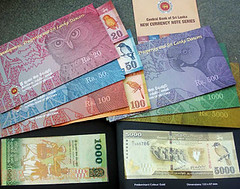 The notes from Rs. 20 to Rs. 5000 are all of the same 67 mm width which is the same as a US dollar. The length of each note is 5 mm longer starting from 128 mm for the Rs. 20 to 153 mm for the Rs. 5000 which is slightly smaller than the US$ and the old Rs.1000. It is probably hoped that they will now not be folded by bus conductors, which reduces the lifetime of the notes.
The notes from Rs. 20 to Rs. 5000 are all of the same 67 mm width which is the same as a US dollar. The length of each note is 5 mm longer starting from 128 mm for the Rs. 20 to 153 mm for the Rs. 5000 which is slightly smaller than the US$ and the old Rs.1000. It is probably hoped that they will now not be folded by bus conductors, which reduces the lifetime of the notes.
The colours are close but not exactly the same as the older notes. The Rs. 20 note, for example is more pink and the Rs. 1000 a lighter green. The Rs. 500 has been made a distinct purple like the rare Rs. 5 notes of 1952 -a colour which was changed to red in the next issue of 1954. Most people I showed the notes to felt the older colours looked richer.
I am very glad that the CBSL met the requests of collectors and for the first time issued sets of six notes with matching serial numbers in a colourful folder with a slip case. The price of Rs.7,500 included an extra Rs. 830 for the folder. The text is only in English. Individual folders are also available for each denomination where the text is in all three languages, Sinhala, Tamil and English. Costing from Rs. 150 to Rs 5,500, depending on the denomination, the full set of six individual folders cost Rs.8100. Only a 1000 of each has been made as collectors' items.
The folder with all six notes seems to be more popular and had serial numbers in the 5000's. The six individual folders had serial numbers in the 6000's and I was lucky to get a set of them with the same serial number. Buying the folders has the additional advantage of getting low serial numbers which hold a numismatic premium.
CBSL has also advertised an uncut sheet of 40 Rs100 notes, sold in a tube for protection. Uncut currency sheets are novelty collector's items overseas.
The CBSL website says the paper used is 100% cotton fibre. It however feels very different to the older notes probably because of the printing. This paper appears to be more synthetic, the surface more polished. The public will take some time to get used to them. In the transition period while the older notes are withdrawn from circulation the smaller notes may get misplaced among the larger older notes.
To read the complete article, see: Taking note of new notes (http://www.sundaytimes.lk/110213/Plus/plus_05.html)
MICHIGAN MOM'S GIANT PENNY: IS IT ART?
That's how one cash-strapped Michigan woman obtained the 84,000 pennies she used to construct a gigantic replica of a 1-cent coin, which won her artistic acclaim and allowed her to share her inspirational story.
Wander Martich says she only started building her massive coin after she was forced to pinch pennies when she went through a divorce, lost her home to foreclosure and lost her job in 2006.
That's when Martich's daughters -- ages 6 and 9 -- gave their mom the loose change they had been saving in their piggy bank.
Martich put her kids' pennies in an empty water jug, which she continued filling with $20 of pennies from each paycheck after she found a job.
Last year, the Grand Rapids, Mich., resident decided to use those pennies to make some real change.
"Art was the only way I could tell a mass of people my story," Martich said in a statement through Ripley's Believe It or Not, which acquired her huge coin. "I wanted to share the message that anyone can do this, you just have to start somewhere. What matters isn't how much you make, but how much you save."
Eventually, she turned to a bank to get coins straight from the U.S. Mint.
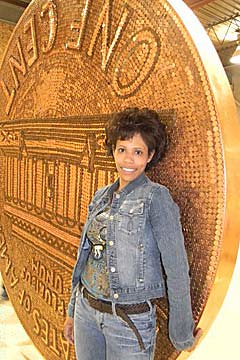 "I needed very shiny pennies to create the highlights," she said. "I wanted to use the different natural shades of pennies to create the image."
"I needed very shiny pennies to create the highlights," she said. "I wanted to use the different natural shades of pennies to create the image."
After working more than 10 hours a day for three months, Martich entered the work -- titled "Helping Mom One Penny at a Time" -- into the ArtPrize contest in Grand Rapids, where it placed sixth and caught the eye of Edward Meyer, Ripley's vice president of exhibits and archives.
To read the complete article, see:
It Took 84,000 Pennies, But Mom's Giant Coin Really Makes Cents
(www.aolnews.com/2011/02/10/it-took-84-000-pennies
-but-michigan-moms-giant-coin-really-mak/)
Dick Johnson adds these thoughts about the article:
A lady in Grand Rapids, Michigan, has glued 84,000 Lincoln cents to a giant 10-foot replica of the reverse of the current Lincoln cent. She calls herself an artist. But this mosaic is neither art, nor is she the artist. Frank Gasparro, of course, was the artist of this coin design.
Methinks the lady had too much time on her hands. The news story relates how she became divorced, lost her job and her home foreclosed. Perhaps gluing cents on a 10-foot wooden frame is therapeutic, but art it is not.
"I needed very shiny pennies to create the highlights," she stated in the article. "I wanted to use the different natural shades of pennies to create the image."
After working more than 10 hours a day for three months, Wander Martich titled the work "Helping Mom One Penny at a Time." She had enlisted the help of two daughters.
Pasting coins on some surface is not original. Silver dollars have been affixed to bar room floors over century ago. A mosaic of Lincoln's portrait appeared recently in Chicago. And restaurants have displayed such coin motifs before. Most interesting is the California gentleman who completely covered his auto with attached cents. Trouble was the total number of the coins dove up the weight of the car and drove down the mileage he got from a gallon of gas.
The coins in your pocket or in your possession are your property. You can do with them what you wish. This is not, however, their intended purpose of a circulating medium. I guess it is fruitless though, to plead for someone with no artistic talent to paste them on something. But whatever you paste up, don't call it art.
MUBARAK'S DOWNFALL COULD THREATEN ROYAL MINT'S COINAGE CONTRACT
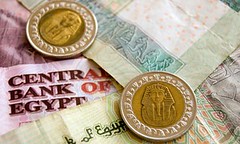 Turmoil in Cairo is fraying nerves at the Royal Mint's factory in south Wales, which has a lucrative deal to supply the Egyptian authorities with more than four billion coins annually for a long-term "recoinage" programme in the north African nation.
Turmoil in Cairo is fraying nerves at the Royal Mint's factory in south Wales, which has a lucrative deal to supply the Egyptian authorities with more than four billion coins annually for a long-term "recoinage" programme in the north African nation.
Egypt is the Royal Mint's second-largest foreign customer, behind Russia, accounting for a substantial chunk of last year's £110m in overseas revenue. Asked if he was keeping an eye on events in Egypt, the mint's chief executive, Adam Lawrence, said: "We certainly would be. There's obviously a bit of volatility in Egypt but we've worked with the Egyptian mint for many years."
The Egyptian government had been renewing its coin supply and much of the new currency is being made at the Royal Mint, which employs 900 people in Llantrisant, near Cardiff. The mint supplies coins in four denominations: five, 10 and 50 piastres and one Egyptian pound.
The uncertainty comes at an awkward time for the mint, which is owned by taxpayers but was given commercial freedom to pursue profitable contracts at the end of 2009.
None of the mint's new coins being dispatched to Egypt, thankfully, bear an image of Hosni Mubarak, who has stepped down after 30 years of rule. Instead, the currency depicts a selection of historical sites, artefacts and figures.
Lawrence said he was unsure what the position of any new regime would be on recoinage: "I honestly don't know. I can't imagine it's top of their priority list."
To read the complete article, see:
Mubarak's downfall threatens Royal Mint's coinage contract in Egypt
(www.guardian.co.uk/world/2011/feb/13/egypt-crisis
-threatens-mint-contract)
FEATURED WEB PAGE: HISTORIA NUMORUM EGYPT
This week's Featured Web Page is the Egypt section of the Digital Historia Numorum from Ed Snible's web site. It is a digital version of Barclay Head's 1911 work, Historia Numorum: A Manual of Greek Numismatics.
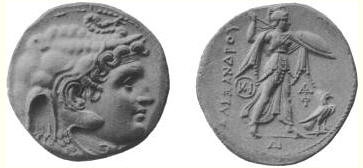
Silver was a common medium of exchange; but, when it passed from hand to hand, its precise value was always determined by weighing. As Dressel has pointed out (Z. f. N., xxii, pp. 231 ff.), there is no other satisfactory explanation of phenomena like the so-called ‘silversmith's hoard' from Naucratis, a find which contained fifteen archaic silver coins of various Greek cities together with 42 oz. of roughly cast and cut up lumps of silver (Num. Chron., 1886, p. 4; cf. for other instances ibid., 1890, pp. 1 ff., and 1899, pp. 269 ff.). The institution of a regular coinage dates from the reign of Alexander the Great, some of whose AV staters and AR tetradrachms are undoubtedly of Egyptian origin. The monarchy that followed the empire of Alexander lasted until Egypt was absorbed by Rome. Consequently civic issues are not to be looked for.
www.snible.org/coins/hn/egypt.html


